Fitting a security chain to your front door or any entrance doors to your home is a great idea and, along with other measures, will certainly bolster the security of your home.
Read on below to learn all about how to fit a chain to your door correctly.
What is a Door Chain?
A door chain is a type of lock that features a chain fixed between a bracket fixed to the door frame and a keep fixed to the door that prevents anyone outside from forcing themselves in when the door is opened.
It is almost always used in conjunction with other security devices such as a peep hole or camera so that you can easily vet any visitors to your home before you actually let them in.
Although a door chain will resist a fair amount of force, extreme force will inevitably rip either the chain bracket or keep from the door, allowing the door to open fully, so due to this it should always be used in conjunction with a good quality door lock such as a 5 lever mortice lock and never used as the main form of locking a door.
When looking to purchase a security door chain, always opt for a good quality product, or the best quality that you can afford. Some cheaper versions will corrode quite badly, or the chains can be quite weak.
Also, if you can, always go for a product that is tested to TS003 (quality standards scheme for door chains) or one that has been Police Approved this will ensure it’s actually up to the job.
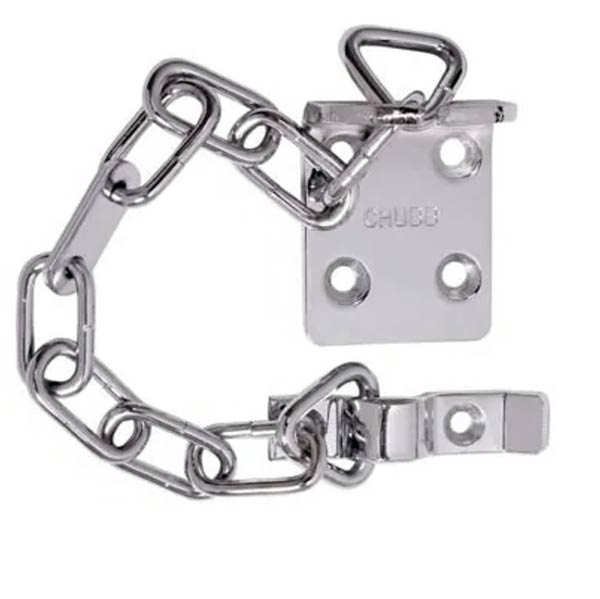
Good quality Chubb door chain
What are the Different Types of Door Chain?
There are 3 different types of security chains made for doors and these are the standard door chain, the lockable door chain and the door chain restrictor. Each different types has its own advantages and disadvantages and situations where it should be used:
Door Chain Restrictor
The door chain restrictor is generally used for UPVC and composite doors where sometimes it can be tricky to drill and screw into them, however they can also be used on any type of door, as long as it has an internal handle.
In these situations, instead of having a keep that is drilled and screwed to the door the chain features a ring that simply slips over the door handy, preventing it from being opened.
Although the other end needs to be drilled and screwed to the frame, this is often much easier than having to fix to the actual door.
Their main advantages are that they are easily fitted, are very effective and are easy to use, especially for the elderly and less able.
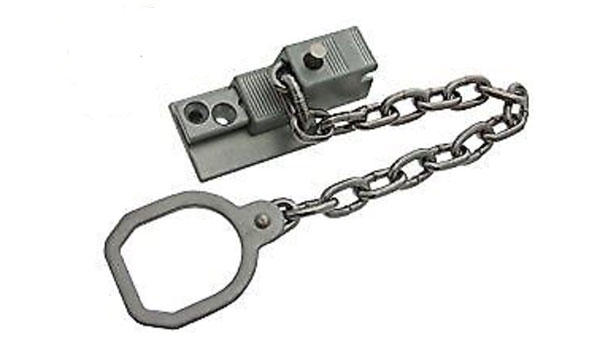
Door restrictor door chain
Standard Door Chain
This is the most common form of door chain there is and if a door chain has been fitted, it is more than likely going to be one of these.
When fitted correctly they are very effective and can resist a fair amount of force so provide a very good level of additional security for any external door.
Their main advantages are that they are cheap to buy, easy to use and fairly easy to install, but if they aren’t installed correctly they can easily fail and cheap varieties can often be sub-standard in quality.
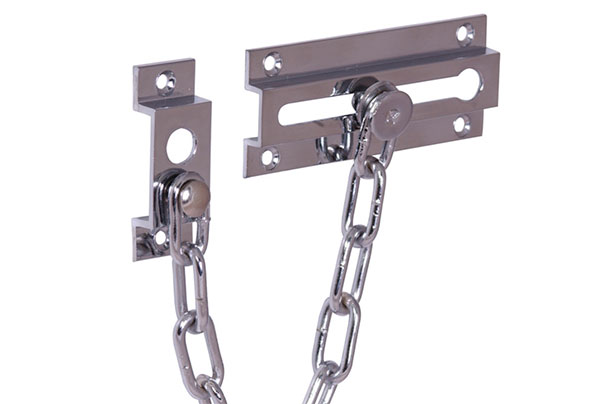
Standard door chain
Lockable Door Chain
The lockable door chain is a step up from the standard door chain. In place of a simple bracket that secures the chain to the door frame there is also a locking mechanism.
The other end of the chain is also fixed to what should be the keep but, in most cases, just allows the chain to slide and doesn’t release it. To open the security chain you need to physically unlock it from the bracket.
As you can imagine, this makes it extremely secure and also child proof, preventing any kids from slipping the chain off and opening the door. Depending on the make and model, some can also be unlocked from the outside.
Their main advantages are that they are much more secure that their standard counterparts, however in an emergency they can also hinder escape from the property.
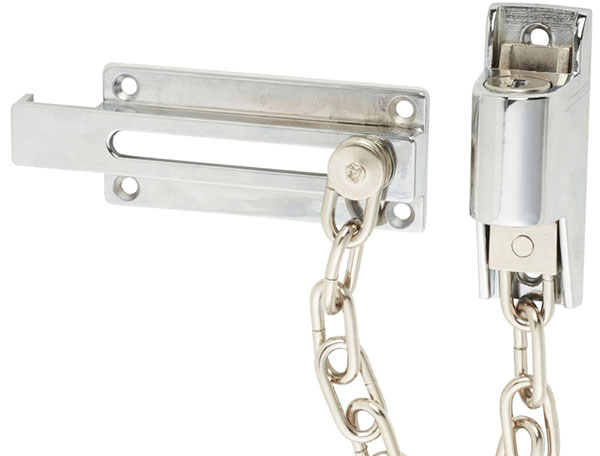
Locking security door chain
Parts of a Security Door Chain?
Security door chains are fairly basic objects and only feature a few parts, however, when fitting them it is important that you know what each individual part is called so that you fit the right part to the right piece of the door.
The main parts of a standard door security chain are as follows:
- Keep (secures the chain to the door)
- Bracket (Secures the chain to the door frame)
- Chain (Secures the bracket to the keep)
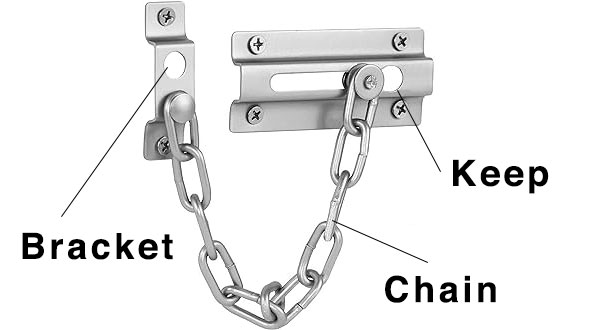
The parts of a standard door security chain
Can you Fit a Door Chain to a UPVC or Composite Door?
Yes it is possible to fit a door security chain to most UPVC and composite doors, however it will ultimately depend on what is in the core of the door and what type of door it is, as to how securely you can fix to it and also what screws you use.
In pretty much all cases, at the core of a UPVC door there will be a steel reinforcing frame and with composite doors there is nearly always a timber core. These exist in order to give the door it’s strength.
In the case of composite doors, timber isn’t an issue as it’s easy to fix into and when done correctly, give a very strong, solid fix, so generally this is fairly easy, as long as you know exactly where the timbers lie.
With UPVC doors this can be a little trickier as to get a strong and lasting fix you will need to drill and screw into the steel core of the door.
With pretty much all UPVC doors, the core of both the door frame and the outer edge of the door will have a steel core so as long as you fix towards the centre you should be fine.
Once you have marked all your fixing holes you will need to drill pilot holes and then you can use suitable self-tapping screws to screw and fix to the frame.
If all of this sounds like too much hassle and faff then you can opt for a door chain restrictor mentioned above.
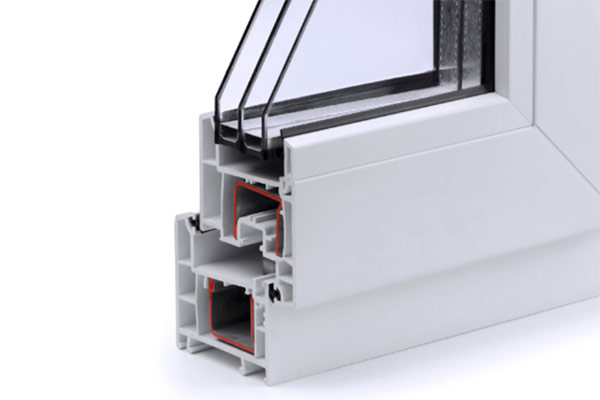
UPVC door frame cross section showing steel core in red
Tips Before you Start Fitting a Door Chain
Before you go ahead and start installing your security chain there are a few points that you need to be aware of in order to get the best job possible.
Letter Box
If it’s a front door you are fixing to then it’s safe to say that there will also be a letter box installed in the centre cross rail.
To fit a letter box it’s necessary to cut a sizable hole in the centre of the rail and by doing so it marginally weakens the timber or steel that’s had a hole cut through it.
If you fix your door chain in line with the letter box then technically this may be a slightly weaker area and if subjected to force, may fail a little quicker.
To remedy this, ensure you fix to the area above the letter box hole and this should be stronger.
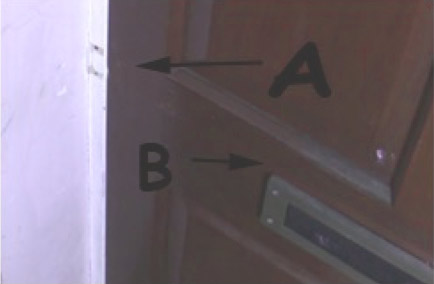
Identifying the wide lock rail of an external door
Storing the Chain
One final point to note is where the chain bracket is fixed and ensuring it is fitted in a way which allows the free end to be hung in the chain bracket slot so that it’s out of the way of both the door and frame. This saves it dangling about and getting caught between the door and frame, which could potentially damage both.
Nearly every chain bracket is designed so that when the chain is not in use it can be hung up, out of the way in the spare section of the bracket (marked A) or whatever storage mechanism your particular chain features.
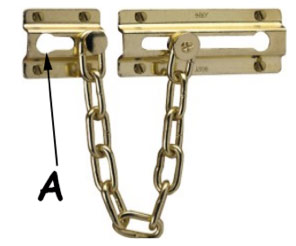
The position of the security chain bracket must allow for safe keeping of the chain
Common Security Chain Dimensions
Most security chains are made to similar dimensions, so if you are thinking of buying one check that you have at least 34mm of door frame showing on the closing side (leading edge) of your door.
If your door frame is particularly thin and is almost entirely covered by architrave then you will need to cut out a section of the architrave to fit the chain bracket.
This can be easily done using a multi-tool and suitable blade or very carefully using a hand saw if you don’t have one.
Measure the height of the chain bracket and then transfer this measurement on to the architrave opposite where the keep will be placed. Keeping the saw or tool straight, cut out section, smooth off with sand paper, repaint and then fix the chain bracket in place.
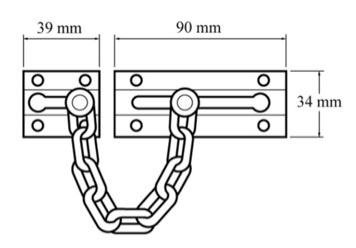
Dimensions of a standard security door chain positioned horizontally
Tools Needed for Fitting a Door Chain
In order to fit a door security chain correctly you will need the following tools and product:
- Chosen door security chain kit
- Pen or pencil
- Small spirit level
- Drill/driver
- Pilot hole drill bits (1mm or so HSS)
- Suitable self-tapping security screws – if screwing into UPVC door steel frame
How to Fit a Door Security Chain
For the purposes of this example we are going to be fitting a standard door security chain on to a timber external door.
Step 1 – Locate Strongest Part of Door
The first step is to locate the strongest part of your door. Usually this is wide rail fitted horizontally in the centre of the door, called the lock rail.
Not all doors feature this so if yours doesn’t, don’t worry. Given that it is an external door you are fitting your security chain to, it will have very strong upright rails, or door jambs as they are called, so you will be fine to fix it in place here.
The lock rail for an external door is designed to receive mortice locks and latches so needs to be a little thicker than the rest of the door, as the mortice lock itself is quite wide.
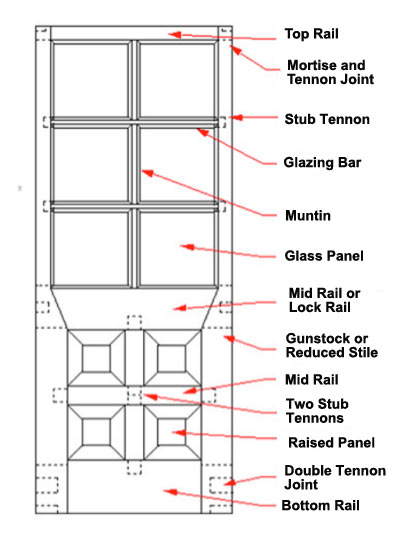
How to identify the different parts of an external door
Step 2 – Position Chain Bracket on Door Frame
Having decided roughly where the main chain keep will go, look to the door frame to position the chain. The chain bracket can be fitted horizontally as shown in the image below, or it can be fitted vertically if needed.
Hold the chain bracket to the frame, opposite the top half of the lock rail (marked A). The reason we fit to the top half of the lock rail (marked B) is because, as mentioned, the letterbox is usually fitted in the centre of this rail and this weakens the centre a little.
Mark the position of the screw holes for the chain. As mentioned it does not matter if the chain is fitted vertically or horizontally, it’s all about the room you have available on the frame.
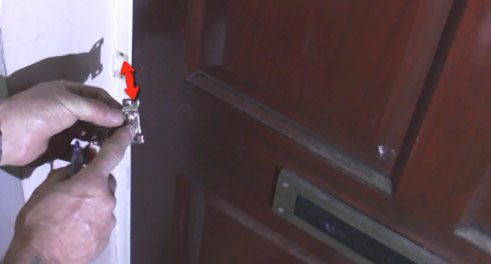
Marking position of screw holes for security chain bracket
Step 3 – Drill and Fix Chain Bracket on Door Frame
Drill pilot holes for the door chain bracket screws. Make sure you use screws which are at least 1-inch (25mm) long.
Quite often the screws sent with the chain are simply not long enough for the job and could easily rip out if the door was given some abuse.
For help and advice of drilling pilot holes, see our project on Pilot Holes and Countersinking here.

Drill pilot holes to screwing up chain bracket easier and more accurate
Fix the security chain bracket with a screwdriver into the pilot holes you have just created. Be careful if you use a battery operated screwdriver in this position as the door frame is very often close up to the door reveal and, if the screws are driven in straight as they really should be, the spinning of the drill chuck could easily rub against the door reveal as do some damage.
In the video below you will see us fitting the screws in at a slight angle. One reason for this is that a door chain had been fitted on this door before, but the screws were too short and the chain got ripped out. We therefore screwed in at an angle to ensure we were getting the best fix possible.
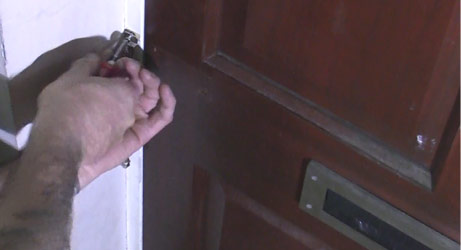
Screwing door chain bracket to door frame
Hang the security chain in the slot provided (A in the image below) to keep it out of the way for step 2.
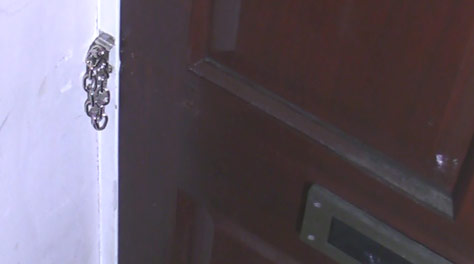
Keeping the security chain out of the way will reduce risk of damage to the edge of the door or door frame
Step 4 – Position Security Door Chain Keep on the Door
Place the security chain keep onto the lock rail of the door, directly opposite the chain bracket you have just fixed. You can use a spirit level to ensure both are level.
To make sure it’s fixed so that the chain can be easily taken out of the keep when the door is closed, drop the chain into the bracket.
Slide the fitting towards the centre of the door so that the chain tightens up, but you are still able to lift it out when the door is closed and open the door an inch or so when you get a visitor.
The main key here is to ensure you can easily converse with any visitors, but no one should be able to get their hand through the gap enough to release the chain from the keep.
In most cases this will mean that the front edge of the keep will be about 50mm from the edge of the door. The nearer the edge of the door you place the keep, the wider the door will open when the chain is locked in its closed position.
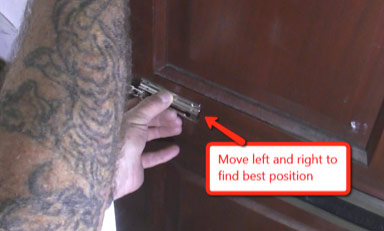
Mark the keep position of the security door chain by sliding it along the lock rail until you are happy
Step 5 – Mark Keep Fixings on Door
When you have established exactly where the keep needs to go so that it can easily be fitted and removed from the keep and also prevent the door from opening too widely, mark its final position.
Hold the keep in position or mark the holes if needed with a pencil or pen. Additionally, before marking them, use a small spirit level such as a boat float to make sure the keep is level.
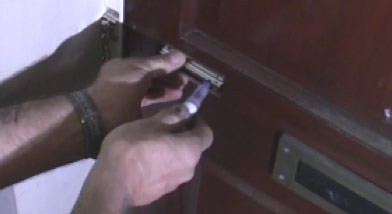
When you are sure of position of chain keep, mark fixing holes
Step 6 – Drill and Fix Keep to Door
Once you have ensured it is level and you have made your marks, put the keep to one side and use a drill/driver to drill your pilot holes as before.
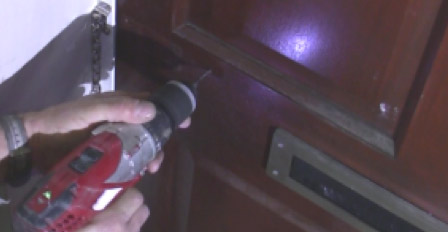
Drilling pilot holes for security chain keep
With your holes now drilled you can fix the keep into its final position. Again, use suitably sized screws if the ones supplied with your door chain kit are not up to the job.
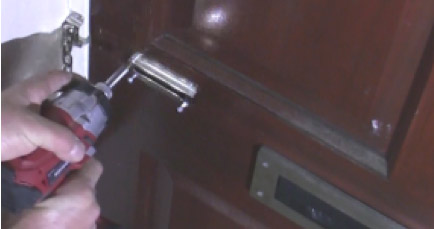
Screw door frame keep to door
Step 7 – Test Security Chain
When you have finished screwing the door chain keep into position, drop the chain into the slot and open the door.
Ask a friend or partner to go outside and try and remove the chain, while the door is open. If you have followed the two previous steps properly and watched the video, of course, they will not be able to.
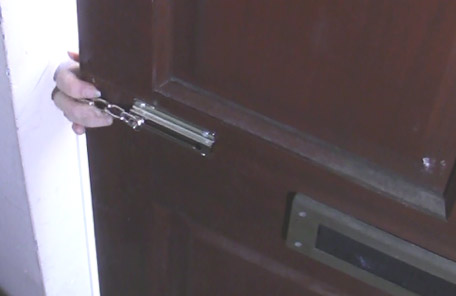
A well fitted and secure door chain will help to foil burglaries
Pat yourself on the back for a job well done!
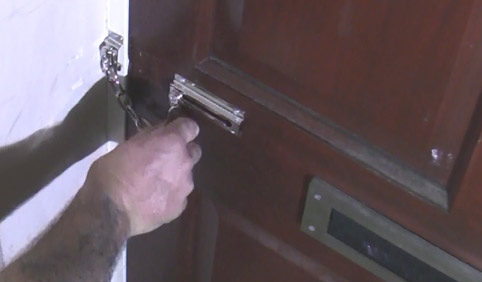
security door chain completely fitted
To improve the security of your front door or indeed any entrance door in your home, fitting a door security chain is an essential job, as in the event someone tries to get in they will be held at bay long enough for you to take action.

